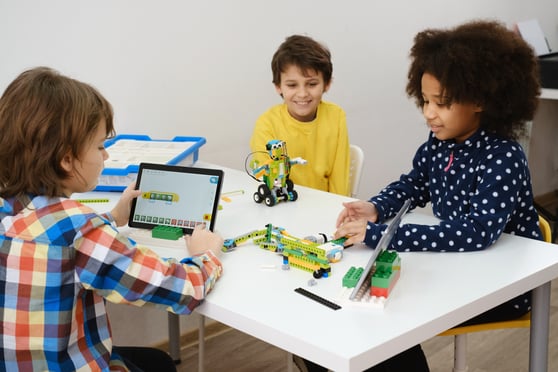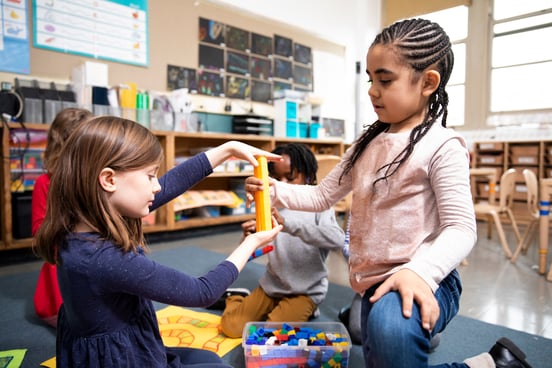Today's students are coming of age in a world vastly distinct from the one their educators experienced during their own formative years.
Consequently, the challenge arises: how can educators effectively connect with students navigating an entirely new reality?
Whether you’re new to a STEM classroom or have been teaching in a STEM environment for a while, you may be seeking some tips and strategies to make your work easier and more effective.
Don't worry; we've got you covered. Our compiled list reflects suggestions rooted in research and will guide those new to STEM and best practices for seasoned practitioners.

What is effective teaching?
Effective teaching is a combination of pedagogical strategies and adaptive methods that can be applied to each individual classroom.
While each classroom's methodology and dynamic is unique, some foundational elements align with effective teaching that is especially helpful in STEM classrooms.
Effective teaching results in pedagogical expertise, adaptability, and a deep commitment to students' growth and success.
It focuses on creating an environment where learning is engaging, meaningful, and supportive, with the ultimate goal of enabling students to reach their full potential.
STEM in the classroom is an effective way of helping students master subject standards.
What does effective teaching look like in STEM?
In STEM classrooms, students rely on well-rounded knowledge to help students succeed academically and in a way that can elevate their sense of belonging in the world they are a part of.
In science and math classrooms, students must use a variety of academic skills to understand and put together concepts and problem-solve complex topics so that they can learn.
STEM classrooms often rely on hands-on or project-based learning to better understand science, technology, engineering, and mathematics. Many strategies can be used for effective teaching in STEM classrooms.
Effective teaching in STEM involves an interactive, inquiry-based, and hands-on approach that connects theoretical knowledge to practical applications, fosters critical thinking and creativity, and prepares students academically and in the real world.
It also considers the evolving nature of STEM fields and the need for ongoing learning and adaptability.
To help students succeed in STEM, educators should create an enriched learning environment where students can interact with content practically and organically.
Effective teaching in STEM fields shares many principles with practical teaching in general but also has specific characteristics that are particularly relevant to these disciplines.
Here Are 10 Effective Teaching Strategies That Can Be Applied In Any STEM Classroom:
- Getting to know the Classroom: Effective teaching strategies begin with understanding the unique demographics of the classroom. No two classrooms are alike, so research and creativity are encouraged to refine these techniques. By getting to know each student in the classroom, educators can modify or provide accommodations for students with various learning styles. Learning the types of learners in the classroom helps guide educators in what style or styles they should teach depending on the student. While certain standards are always best practices, creativity, like moving the seating chart frequently, doing rotational activities, and analyzing student data, can be especially valuable for instructors and administration.
- Real-World Application: The basis of STEM is applying knowledge in a practical and helpful way to progress the world. If students do not believe that what is being taught is relevant to their real lives, they will not care to learn about it. When students interact with STEM content in a natural way, it becomes meaningful and relevant to them. It may even spark their interest in a future STEM career! Since students are currently growing up in a world of STEM all around them, it is important for them to understand that they already interact with the concepts taught in STEM subjects. Applying real-world scenarios helps close those learning gaps for students. It can include activities using social media, AI, bringing in a speaker of interest on the topic, and so much more.
- Using Technology: In the past, technology was considered a crutch and not something to wholly lean on in education. That has since significantly changed, and whether it is liked or not, technology is a part of everyday life in these times. Students should not be scolded for using technology but instead use that technology for academic success, progress, and purpose. STEM technology is helpful for mastering subject standards and preparing students for the real world, too. Using technology in the classroom is an especially effective strategy for teaching students in STEM because they are typically already familiar with technology in some sort of way and interested in learning more about it. Technology is perhaps the most rapidly advancing field in the world, and current students are the present and future of that industry. In the classroom, interactive simulations, artificial intelligence, digital content, and even games are ways to bring technology into STEM classrooms. STEM tools, like 3D printers, are also especially useful in teaching complex topics in the classroom.
- Project-Based Learning: Students in STEM classrooms often use their hands to build or create things that can help them better understand STEM concepts. Examples of STEM education include project-based learning, where students can lead with creativity and innovation to learn complicated ideas in subjects like physics, biology, and engineering. Examples include building a school garden, building algorithms for AI, introductory website development, robotics construction, chemical experimentation, field research, and so much more. With project-based learning, students can focus their interests on various STEM industry concepts to expand their scientific knowledge.
- Collaborative Learning: Working together is a required life skill that must be thought of regardless of age or career choice. It is a part of humanity! Collaborative learning in the STEM classroom allows students to work together while simultaneously excelling in their individual roles in the group as well. This allows all group members to succeed at the activity collectively. Students should be paired together with thoughtfulness so that the activities go smoothly. One example is rotations, where students spend a certain amount of time at each station completing an experiment or task before moving on to the next area. This can be applied to various scientific topics, and creativity is encouraged. Student groups are typically two to four with no more than five to reduce distractions and so that everyone has a designated group role.
- Active Inquiry: Educators should consider active inquiry in their STEM classrooms so that students can form their own ideas and questions about a topic. One way to effectively engage students in this way is to bring in a guest speaker. This could be done in person or digitally, which makes it incredibly convenient! Students can ask questions and learn valuable information from experts in their field. Another way to try this strategy is by taking students on field trips to museums or zoos.
- Engineering Design Process: A critical element of STEM education is explicit instruction in the Engineering Design Process (EDP).
|
EDP’s five stages:
Ask — Identify a problem and ask questions and research information to better understand how to solve it or the approach needed to solve it.
Imagine — Imagine the technology that would solve the problem.
Plan — Establish a plan to create your technology.
Create — Create technology and see how it measures up in solving the problem.
Evaluate & Improve — Collect and analyze data to see if the solution works. Evaluate strengths and weaknesses. Make any adjustments and test again.
|
- Ethical Considerations: The climate of science is constantly changing or being debated. It is important for students to examine the history of STEM subjects and consider the progress that can be made for the future. One way to facilitate this strategy is by highlighting minorities or women in science, ultimately connecting all the important players of science and showing students that everyone is welcomed in the scientific community if desired.
- Creative Encouragement: Allowing students to be creative and passionate is a great way for students to show their talents and skills on a particular STEM subject or project. This can be done in a variety of ways, like projects where students can lead the theme or style of how the assignment is created. STEM education examples could include having students create a pamphlet on a particular subject. Educators can create a general rubric but allow students to be creative in their style and application of knowledge. It could be paper-based, digital, or a combination. It is great to see various minds work on the same STEM topics in so many different ways!
- Formative Assessments and Progress Monitoring: Amongst the variety of strategies, it is important for educators to monitor if students are truly learning and succeeding in the STEM classroom. Progress monitoring and formative assessments are imperative to data collection and analysis. This can include a variety of paper or digital-based content like bellringers, exit tickets, quizzes, or district assessments. With consistent monitoring, educators can better understand their students' needs and what does or does not work for them.
STEM Classroom Design
A STEM classroom should be welcoming, inquisitive, and professional.
It should allow students a place to be creative, collaborative, focused, and always ready to learn. Students should never be bored in the STEM classroom, and they should always have reinforcement and structure to their daily learning.
Educators who can create a consistent routine are better equipped to teach a classroom that is filled with diverse learners. STEM classrooms should be creative and adaptable, just like STEM.
Interested in learning more? See how STEM learning can transform your classroom. Reach out and learn more!




